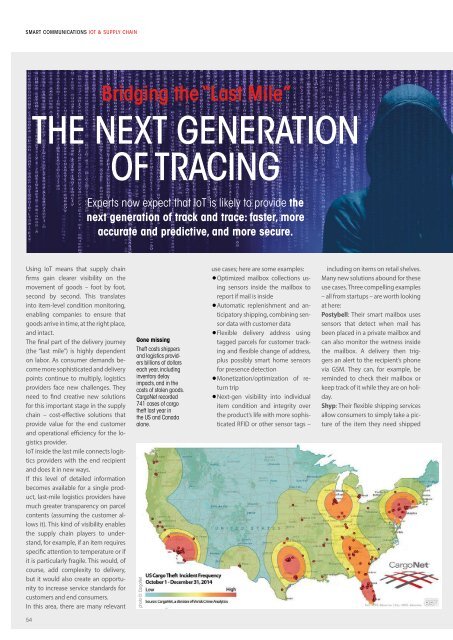Smart Industry 2/2018
Smart Industry 2/2018 - The IoT Business Magazine - powered by Avnet Silica
Smart Industry 2/2018 - The IoT Business Magazine - powered by Avnet Silica
You also want an ePaper? Increase the reach of your titles
YUMPU automatically turns print PDFs into web optimized ePapers that Google loves.
<strong>Smart</strong> Communications IoT & Supply Chain<br />
Bridging the “Last Mile”<br />
The next generation<br />
of tracing<br />
Experts now expect that IoT is likely to provide the<br />
next generation of track and trace: faster, more<br />
accurate and predictive, and more secure.<br />
Using IoT means that supply chain<br />
firms gain clearer visibility on the<br />
movement of goods – foot by foot,<br />
second by second. This translates<br />
into item-level condition monitoring,<br />
enabling companies to ensure that<br />
goods arrive in time, at the right place,<br />
and intact.<br />
The final part of the delivery journey<br />
(the “last mile”) is highly dependent<br />
on labor. As consumer demands become<br />
more sophisticated and delivery<br />
points continue to multiply, logistics<br />
providers face new challenges. They<br />
need to find creative new solutions<br />
for this important stage in the supply<br />
chain – cost-effective solutions that<br />
provide value for the end customer<br />
and operational efficiency for the logistics<br />
provider.<br />
IoT inside the last mile connects logistics<br />
providers with the end recipient<br />
and does it in new ways.<br />
If this level of detailed information<br />
becomes available for a single product,<br />
last-mile logistics providers have<br />
much greater transparency on parcel<br />
contents (assuming the customer allows<br />
it). This kind of visibility enables<br />
the supply chain players to understand,<br />
for example, if an item requires<br />
specific attention to temperature or if<br />
it is particularly fragile. This would, of<br />
course, add complexity to delivery,<br />
but it would also create an opportunity<br />
to increase service standards for<br />
customers and end consumers.<br />
In this area, there are many relevant<br />
Gone missing<br />
Theft costs shippers<br />
and logistics providers<br />
billions of dollars<br />
each year, including<br />
inventory delay<br />
impacts, and in the<br />
costs of stolen goods.<br />
CargoNet recorded<br />
741 cases of cargo<br />
theft last year in<br />
the US and Canada<br />
alone.<br />
photo ©: CargoNet<br />
use cases; here are some examples:<br />
• Optimized mailbox collections using<br />
sensors inside the mailbox to<br />
report if mail is inside<br />
• Automatic replenishment and anticipatory<br />
shipping, combining sensor<br />
data with customer data<br />
• Flexible delivery address using<br />
tagged parcels for customer tracking<br />
and flexible change of address,<br />
plus possibly smart home sensors<br />
for presence detection<br />
• Monetization/optimization of return<br />
trip<br />
• Next-gen visibility into individual<br />
item condition and integrity over<br />
the product’s life with more sophisticated<br />
RFID or other sensor tags –<br />
including on items on retail shelves.<br />
Many new solutions abound for these<br />
use cases. Three compelling examples<br />
– all from startups – are worth looking<br />
at here:<br />
Postybell: Their smart mailbox uses<br />
sensors that detect when mail has<br />
been placed in a private mailbox and<br />
can also monitor the wetness inside<br />
the mailbox. A delivery then triggers<br />
an alert to the recipient’s phone<br />
via GSM. They can, for example, be<br />
reminded to check their mailbox or<br />
keep track of it while they are on holiday.<br />
Shyp: Their flexible shipping services<br />
allow consumers to simply take a picture<br />
of the item they need shipped<br />
54
















